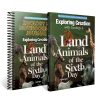Your bag is empty
Don't miss out on great deals! Start shopping or Sign in to view products added.
Shop What's New Sign in$117.28
Available in stock
Exploring Creation with Zoology 3: Land Animals of the Sixth Day is a homeschool science course for elementary grades K-6 and part of our Young Explorer Series authored by Jeannie Fulbright. Exploring Creation with Zoology 3 is part of the award-winning Young Explorer Series–voted the #1 homeschool science curriculum for over 11 years in a row.
What separates people from apes? How can a Great Dane be related to a Chihuahua? Is there evidence that people and dinosaurs lived at the same time? What should you do if you encounter a bear? How can you tell if a snake is poisonous? Come find out answers to these questions and many, many more with Apologia’s Exploring Creation with Zoology 3!
This third book in the zoology series takes students on a safari through jungles, deserts, forests, farms, and even their own backyard to explore, examine and enjoy the enchanting creatures God designed to inhabit the terrain. Families will snuggle together and discover the amazing animals from primates to parasites, kangaroos to caimans, and turtles to terrifying T-Rex—and the safari doesn’t end there!
Students will also keep a record of where each animal is found on a map and learn to identify animal tracks. As with all the Apologia elementary books, students will continue the practice of narration, keeping a notebook of what they have learned, and enjoy many hands-on projects and experiments throughout the course. You may view a sample of the course by clicking here.
There are 14 lessons included in this one-year Zoology 3 course. A detailed daily lesson plan is included in the Notebooking Journals.
Lesson topics include:
To complete this Zoology 3 course, we recommend the hard-cover textbook and spiral Notebooking Journal (grades 4-6) or the Junior Notebooking Journal for early elementary ages or children with limited writing skills.
This Zoology 3 course for elementary grades is packed with a variety of hands-on activities, experiments, and projects. These can be completed with household materials. You may view the complete list of lab supplies by clicking here.
The activities and projects use easy-to-find household items and truly make the lessons come alive!
Powerful projects for this course include:
We have provided a detailed daily schedule for Exploring Creation with Zoology 3 in the front of each Notebooking Journal and Junior Notebooking Journal. This schedule outlines what to read and what activities to complete, as it fits your family’s needs.
We recommend that you spend the entire school year covering this book, devoting approximately two sessions per week to the course.
A perfect complement to Exploring Creation with Zoology 3: Land Animals of the Sixth Day, the Zoology 3 Notebooking Journal provides everything your student needs to complete his study of Zoology 3. Not only does it include all the wonderful features of our Junior Notebooking Journals in the Young Explorer Series, but it also includes as many additional activities, projects and experiments that can be completed in one day or less.
This Notebooking Journal will serve as your child’s individual notebook, providing a place for him to complete every assignment in the text. He will illustrate and record fascinating facts and information learned during each lesson, complete the notebooking assignments on specially designed templates, record experiments, activities and projects, complete vocabulary crossword puzzles, put together beautifully designed miniature books, and more!
Keeping a scientific notebook has always been standard scientific practice. Apologia’s Notebooking Journals have been designed to:
The regular Notebooking Journal for Exploring Creation with Zoology 3 is recommended for use with students who have mastered handwriting, can take notes, and enjoy upper elementary level activities. The regular Notebooking Journals include the following features that are not in the Junior Notebooking Journals:
The Junior Notebooking Journals are designed for younger students who are still developing basic writing skills. These journals have easier crossword puzzles and activities, easier crossword puzzles and activities, and wider writing lines.
The regular Notebooking Journals and Junior Notebooking Journals are designed to work together to help accommodate teaching multiple ages in your homeschool.
In this Notebooking Journal, you will find:
Your child will treasure his Notebooking Journal as he makes it his very own with words and illustrations, reflecting all he has learned in his pursuit of science. Additionally, the journal will serve as your record of your student’s scientific endeavors throughout the year. When your child flips through his notebook, he will be reminded of the knowledge he has attained as he peruses the pages he has created. A variety of activities include full-color mini-books, additional fun experiments, crosswords, and supplementary materials. You may browse a sample of the course by clicking here.
| ISBN 13 | 978-1-932012-85-9 |
|---|---|
| Author | Fulbright, Jeannie |
| Publisher | Apologia Educational Ministries |
| Format | Hardcover |
| Grade | |
| Subject |
| Weight | 1.3 kg |
|---|---|
| Dimensions | 11.25 × 8.75 × .8 in |
| ISBN 13 | 978-1-932012-85-9 |
| Author | Fulbright, Jeannie |
| Publisher | Apologia Educational Ministries |
| Format | Hardcover |
| Grade | |
| Subject |
| Weight | .6 kg |
|---|---|
| Dimensions | 11.25 × 8.75 × .6 in |
| ISBN 13 | 978-1-935495-13-0 |
| Author | Fulbright, Jeannie |
| Publisher | Apologia Educational Ministries |
| Format | Coil bound |
| Grade | |
| Subject |

Reviews
There are no reviews yet